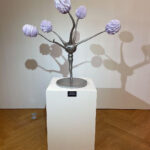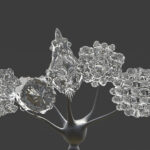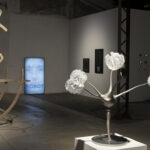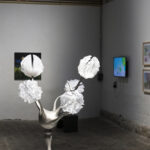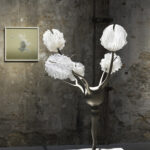“I just saw you in a dream (Je viens de te voir en rêve)” by Marion Roche
Title:
Artist(s) and People Involved:
Exhibiting Artist(s):
Symposium:
Venue(s):
Artist Statement:
Hacnum Exhibition. various locations, May 16 – 21
Fusion of the Possible, Topographie de l’art, April 15 – June15
Take a few minutes, lie down, close your eyes. Breathe deeply, relax your muscles, and let yourself merge with the mattress… The sounds around you fade away, and images appear under your eyelids. You feel yourself being gently carried away to another reality as you fall asleep; a journey begins.
It is no secret that dreams, in all their aspects, have always been a mystery. Neuroscientists are still learning about it, while philosophers are questioning the boundaries of reality. On a personal level, they can even influence our decisions. The dream is the most intimate thing we have and yet it is so limited in terms of knowledge; Marion Roche is fascinated by this paradox. She sees the opportunity here to take an artistic approach and establish a dialogue between art and science; her project “Je viens de te voir en rêve” (I just saw you in dream) is a sculptural experiment with a touch of 4D technology.
Artist, researcher and philosopher, Marion is interested in the notion of process. Sculpture is her predominant practice, but she finds it increasingly difficult to focus on fixed forms. She has been working on the idea of “becoming” for some time now, but it is the new formula of the MAIF prize for sculpture that catches her attention; Since 2020, candidates are asked to take on a new technology that they have not mastered. She takes up the challenge; her sculpture will not only be in motion, but also in the process of becoming.
Things get tricky when she has to find a technique that meets her criteria. Then she remembers an anecdote about glass: To the touch, it feels solid, but on a microscopic scale, the atoms are not fixed, just like in a liquid state. Inspired by this astonishing fact, she starts looking for the existence of similar materials and ends up discovering an experimental process that is similar to this phenomenon: 4D printing.
We already know how 3D printing works: it consists of stacking layers of material successively until a volume is created. 4D adds a temporal dimension to the 3D printed object. An object can then react over time according to external factors, such as humidity or temperature, and will therefore be mobile.
And it is precisely in Lyon, Marion’s home city, that one of the few research centres for 4D in the world is located; the 3d.FAB. They specialise in medical research, for example by creating autonomous heart valves that react to heat.
Marion is very pleased with this technique, as it fits perfectly with her philosophy and subject. She presents her idea to one of the scientists of the Neuroscience Research Centre of Lyon, and starts her journey to the realm of dreams. They are produced by a ballet of neuronal connections, which puts our brain in a state of ebullition; our body remains inactive, hence the notion of “REM sleep” (Rapid Eye Movement). And it is by looking at the intensity of the electrical activity of our brain that scientists can determine when we are dreaming.
Together, they established a protocol: Marion would sleep for a given time, her dream would be transcribed into an electroencephalogram (or EEG) and described immediately upon waking, to produce a 2D vision of it. She will take five naps in total.
Once these elements are in hand, Marion works with Benjamin Petit at the LTBL studio (of which she is herself the artistic director) on the design of the 3D object, whose form corresponds to the activity of the dream, stratified in time.
The creation then goes through the 3d.FAB, where Marion collaborates with a post-doctoral researcher to find the ideal combination of materials; she imposes aesthetic choices such as transparency or rigidity for example.
And this is what we should see when the project comes to an end: a visualisation of the artist’s dreams. The forged aluminium base takes the form of a tree trunk, but in fact represents a neuron, which supports five structures, the five dreams. Each one has an inscription that evokes the dream at its origin. They open and close according to one factor: hydration.
Other Information:
Website:
Additional Images:
- 2023 Roche I just saw you in a dream
- 2023 Roche I just saw you in a dream
- 2023 Roche I just saw you in a dream
- 2023 Roche I just saw you in a dream


